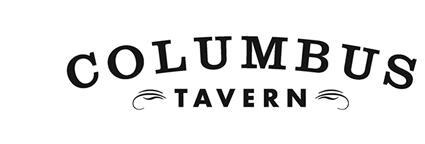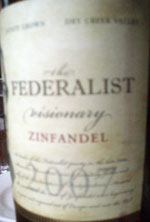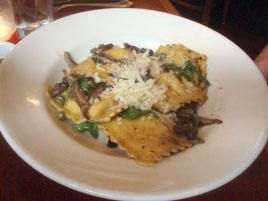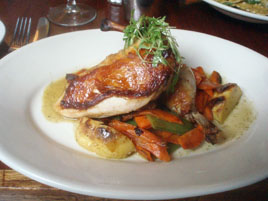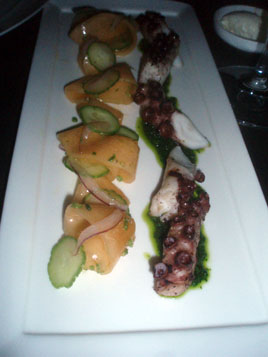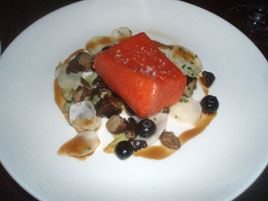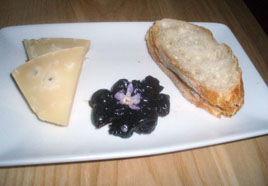Note: This is a review of the 4×4 grid-format menu that Eleven Madison Park was using for a while. The restaurant has since changed to a more conventional tasting menu, which I have not yet tried.
*
 A year ago, chef Daniel Humm and general manager Will Guidara of Eleven Madison Park “decided to fix what ain’t broke.” They jettisoned their à la carte menu in favor of a laconic square grid of sixteen ingredients. Unless you ask, you’ll have no idea if “Lobster” is a risotto, a bisque, a thermidor, or something else.
A year ago, chef Daniel Humm and general manager Will Guidara of Eleven Madison Park “decided to fix what ain’t broke.” They jettisoned their à la carte menu in favor of a laconic square grid of sixteen ingredients. Unless you ask, you’ll have no idea if “Lobster” is a risotto, a bisque, a thermidor, or something else.
“Tasting menus are like monologues,” Guidara told The Times. “This is a dialogue.”
But as one Chowhounder put it (quoted in The Post), “I don’t want no stinkin’ dialogue! When I go to a world-class restaurant, I want the chef to take care of me.”
 At Eleven Madison Park, you are, of course, welcome to have as much of a “dialogue”—or as little—as you want. This being a Danny Meyer restaurant, the server will stand there all night and explain every dish, if that’s what you want. But you don’t really want that, do you? You’re probably just going to select one ingredient from each row of the grid, communicate any allergies, and be done with it.
At Eleven Madison Park, you are, of course, welcome to have as much of a “dialogue”—or as little—as you want. This being a Danny Meyer restaurant, the server will stand there all night and explain every dish, if that’s what you want. But you don’t really want that, do you? You’re probably just going to select one ingredient from each row of the grid, communicate any allergies, and be done with it.
If the poor crybaby Chowhounder cannot be bothered to name four ingredients ($125), he can order the tasting menu ($195) and get whatever the chef chooses to send out. Another crybaby Chowhounder (they do moan a lot there) went so far as to call the new menu “a scam.”
Of course it is not a scam. Not even close. What it is, at least arguably, is a gimmick.
Eleven Madison Park is serving what amounts to a mystery tasting menu, where the appetizer, two entrées, and the dessert, can be chosen from a cryptic list of four items each. Plenty of restaurants offer tasting menus where none of the items are described at all. EMP’s own $195 menu operates that way. Plenty of others offer tasting menus where the ingredients are listed in some detail, but where most or all of the courses offer no choice at all.
This menu is a hybrid, a tasting menu with a few degrees of freedom, but with most of it a surprise unless you are awfully inquisitive. The gimmick is the “dialogue,” which doesn’t really exist—except in the sense it does at any restaurant that offers diners a choice, which is to say, most of them.
At our excellent dinner last Friday evening, we weren’t at all affronted by the 4×4 grid. It isn’t very helpful, either. Wouldn’t it be better to write down the choices the way a conventional restaurant would? The kitchen clearly has a preparation in mind for each of the sixteen ingredients. It doesn’t make them up on the fly. So why not tell us?
*
The service is practically the best of its kind. On entering, the greeter asked for the name of our reservation. When I said “Shepherd,” he said to my friend, without missing a beat or consulting a list, “Welcome. You must be ____.” To memorize every booking is impressive enough. To know my companion’s name is unheard of. At the table, a handwritten birthday card was waiting for her.
As you’d expect, plates and flatware were set and cleared seamlessly, every request honored instantly, every need anticipated. It is a performance perhaps half-a-dozen restaurants in town can match.
 The meal begins with something like four or five flights of amuses. I didn’t note them all, but the tour de force was a “clam bake,” with four delicate canapés and a broth that the server pours into a contraption heated by hot rocks, simulating a beach clam bake in miniature.
The meal begins with something like four or five flights of amuses. I didn’t note them all, but the tour de force was a “clam bake,” with four delicate canapés and a broth that the server pours into a contraption heated by hot rocks, simulating a beach clam bake in miniature.
From the first row of the menu grid, my friend and I both chose “Rabbit,” which I correctly guessed would be a luscious, creamy terrine, as it was in the position on the grid that I know (from other reviews) is usually represented by a foie gras terrine. Without the advance research I did, no other diner would know this.
Had the meal ended here, I would give Eleven Madison Park the same four stars that Frank Bruni did. Instead, I was reminded of Bruni’s comment at the end of 2008, that: “one in every three dishes didn’t measure up to the others (though nothing — nothing — was wholly undistinguished).” It seemed there were two restaurants here, with a completely different kitchen responsible for everything after the appetizer.
The statement that “nothing — nothing — was wholly undistinguished” could apply to my friend’s Loup de Mer, her Pork, and my Chicken. But I would not call them distinguished either. Somewhat more impressive was Lobster wrapped in fat, rich noodles, a lasagne of the gods. It was the only savory dish that I would care to see again. There was nothing wrong with the others, but there was no wow! in them.
Even less memorable were pastry chef Angela Pinkerton’s desserts, “Berries” and “Apricot, and the petits fours were noticeably less impressive than at the other four-star restaurants. We weren’t served a birthday cake, either—just a lit candle poking out from the dessert we had already paid for. I didn’t actually need another cake at that point, but see my reviews of Asiate and Del Posto for how the pastry departments in comparable restaurants usually honor such an occasion.
Wine pairings are $95 per person, and if you ask the sommelier to “be creative,” he will. I lost count, but I believe there were six or seven pours, ranging from beer to sake to cocktails, and of course wines, all with decent age on them; most were off the beaten path. Where my friend and I ordered different items, the wines were different also. For one course, the sommelier couldn’t decide between a cocktail and wine, so he gave both.
The final pour, as many reviews have noted, is a bottle of digestif that the sommelier leaves on the table for you to take as much as you would like. It is a safe bet that most normal folk will be too full to abuse the privilege. This must be the best wine pairing in the city, aside from Per Se, which charges at least double for similar service.
If my review seems harsh, it is not. I adore Eleven Madison Park. This is my third visit since chef Humm came on board (here, here). The four-course menu at $125 is one of the best dining deals in town, given all the extras that come with it. What I don’t see, however, is the leap to four stars that other publications have claimed.
Eleven Madison Park (11 Madison Avenue at 24th Street, Flatiron District)
Cuisine: Hard to classify; extraordinary at its best, but occasionally falls flat
Service: Incomparable; arguably the best in the city
Ambiance: Superb; an elegant, high-ceilinged space in a landmarked building
Rating: ★★★
 Monday, August 29, 2011 at 02:46PM
Monday, August 29, 2011 at 02:46PM 
 Lauren Shockey in the Village Voice gave it a “meh.” Sam Sifton filed a “brief,” as he much prefers reviewing club joints and restaurants that peaked in the 1980s.
Lauren Shockey in the Village Voice gave it a “meh.” Sam Sifton filed a “brief,” as he much prefers reviewing club joints and restaurants that peaked in the 1980s. The original idea has quietly been pushed to the side. Uninspired dishes like pasta carbonara, steak frites, moules frites, and beet salad, no longer appear on the menu. Prices are moderate, with most appetizers below $15 and most entrées below $25. (The most expensive item is a Venison Wellington, $27.)
The original idea has quietly been pushed to the side. Uninspired dishes like pasta carbonara, steak frites, moules frites, and beet salad, no longer appear on the menu. Prices are moderate, with most appetizers below $15 and most entrées below $25. (The most expensive item is a Venison Wellington, $27.)














